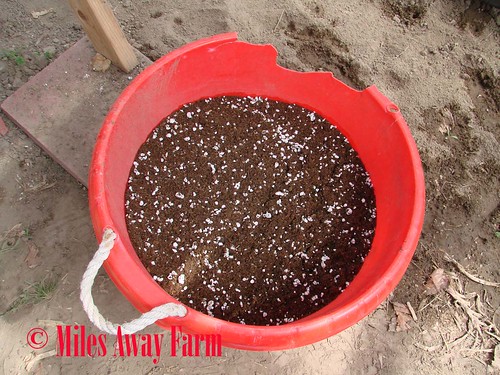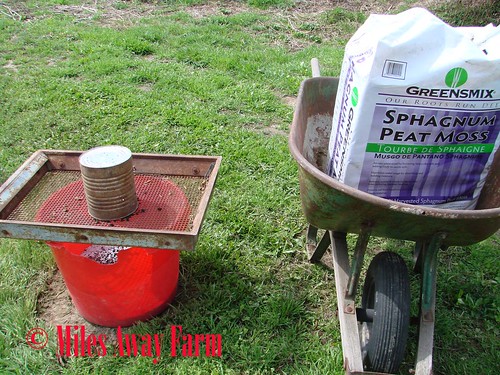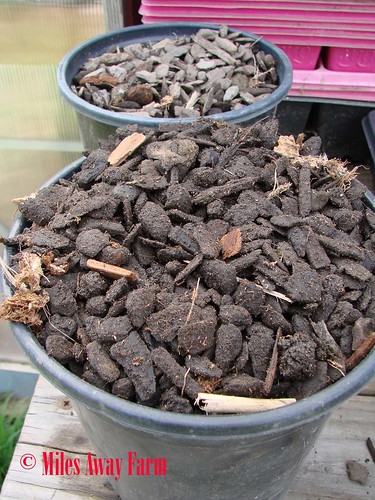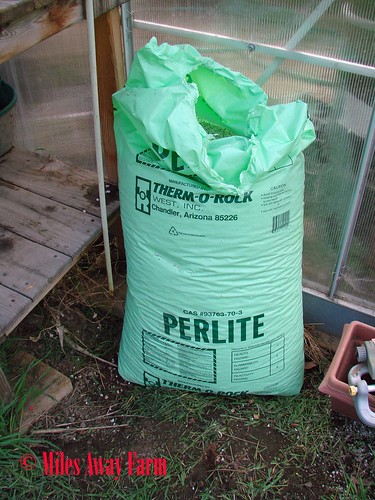 I used to just buy bags of potting soil at the big box stores. Then I graduated to starting my own seeds, and had to search high and low for “seed starting mix”, which is finer grained than “potting mix” and less common. Then I started to really get serious about seed starting (I currently have about 50 flats of seedlings in my greenhouse) and buying seed starting mix just wasn’t a financial option any more.
I used to just buy bags of potting soil at the big box stores. Then I graduated to starting my own seeds, and had to search high and low for “seed starting mix”, which is finer grained than “potting mix” and less common. Then I started to really get serious about seed starting (I currently have about 50 flats of seedlings in my greenhouse) and buying seed starting mix just wasn’t a financial option any more.
About this time, I read Eliot Coleman’s book “The New Organic Grower”, and in it, he talked about using a “soil blocker” so that you didn’t have to have small plastic pots everywhere. In that discussion, he provided a recipe for his “soil blocking mix”. I tried the soil blockers. They were kind of hit and miss for me. But I’ve been making my own seed starting mix, based on his recipe, for several years now.

Metal coffee cans are getting harder and harder to find. This one happened to come with the property. How I got this soil sifter is a long story (and it really is a soil sifter, that was its original purpose). But I’ve made my own with 2×4’s and hardware cloth as well.
This recipe is in “parts”. For me, a “part” is an old metal coffee can. The larger kind that used to hold 3 lbs of coffee (about 12 cups). If you wanted to make more at once, you could use a 5 gallon bucket. Less? You could use a pint jar. That’s the beauty of “parts”. It can be whatever size you want.
- 3 parts Sphagnum peat moss (or coconut coir, if you can get it for a reasonable price)
- 2 parts perlite (if you have a choice, get the smaller sized grains, but you probably won’t have a choice)
- 2 parts compost (well aged home-grown if you have it – I like mushroom compost if you have to buy store bought)
- 1 part native soil
- handful of organic fertilizer (about 1/2 cup)
- small handful of garden lime to adjust the pH (about 1/4 cup) (a bit of wood ashes could work as a substitute).
Sift all components into large container through hardware cloth or other small holed (but not too small unless you want to lose your mind) sifter. Toss any larger sticks, roots, dried plant matter, rocks etc. aside. I layer mine one can at a time like this: peat, compost, perlite, peat, soil, fertilizer, lime, compost, perlite, peat. Then get your arms in there and mix it really well (I yearn for the day when I’ll have a portable cement mixer for this purpose). Add water to make it moist if necessary, but don’t saturate. One batch of this mix will fill 6 1/2 flats. My flats are the standard black trays that are called 1020’s because they are about 10 inches wide and 20 inches long. For comparison, I purchased a bag of “seed starting mix” for $8 that filled 5 1/2 trays.

This was the chunky stuff from the mushroom compost that didn’t go through the sifter. I save it for the bottom of flower pots, for coarse drainage. Works great.
Here are some notes on the composition.
Peat moss. Peat can hold a huge amount of moisture, ensuring that your seeds, and later your plants, don’t dry out. It also hangs onto nutrients and is light enough that young roots can easily penetrate into it. Peat is naturally acidic, which helps but does not eliminate damping off issues. It’s also an organic product, eventually decomposing completely. There was some speculation a while back that peat was a non-renewable resource and shouldn’t be used, but that has pretty much been debunked. If you can find coconut coir (the ground outer hulls of coconuts) it can be substituted for peat. It has a more neutral pH and is an awesome product, but as I’ve never lived near where it is produced, it’s always outrageously expensive, so I rarely purchase it.
Perlite. Perlite is basically exploded obsidian rock. When its heated to high temperatures, it expands to more than 10 times its original size, and becomes light weight and porous. It’s added to soil mixes to keep the soil from compacting and to encourage good drainage. You can substitute vermiculite, but it is more expensive, and doesn’t do as good of a job of keeping the soil aerated. Save the vermiculite as a topping when planting your seeds in the flats, as it holds moisture better and discourages fungus and moss growth.
Compost. Compost is plant matter (or digested plant matter in the form of manure) that has decayed over time into some of its more base components. It contains trace nutrients and minerals that will slowly feed plants (and more importantly, the micro-ecology of the soil). It also retains water and keeps soil from becoming compacted. There’s a saying in gardening; compost covers all soil sins. Soil too sandy? Add compost. Soil have too much clay? Add compost. Soil nutrients not balanced? Add compost.
Organic Fertilizer. I buy 25 lb bags of ready mixed organic fertilizer. It’s OMRI (Organic Materials Review Institute) approved, and contains a bit of mycorrhizae. It’s relatively slow release. You don’t want much when plants are really small. I top dress with more once they are up and growing well. (Update: I now make my own organic fertilizer, via the methods found here).
Garden soil. Yup, that’s right. I add some of my local soil into my mix. Some would frown on this, but I see it as an inoculation. After all, that’s the soil these plants are eventually going to be living in. I don’t want it to come as a huge shock when they get moved into the ground. I want it to feel like more of the same.
As for the possible disease issues that can come from introducing garden soil, I find that about 99% of the issues I have with seedling disease problems come from overwatering. DON’T OVERWATER.
The garden lime, by the way, is to counter some of the pH from the peat. Peat has a pH that is very acidic (which is also why you see it added around plants that love acidic soils, like blueberries and azaleas). I measured the pH of my peat moss and it was 4.6. Most garden vegetables do best with a pH between 6 and 7. So adding a bit of lime, plus the other ingredients, will help rebalance your mix.
Later in the season, when I’m potting up larger plants or filling larger outdoor pots, I will change up this mix a bit, dropping some of the peat and adding in an extra scoop of native soil.
I haven’t actually broken down what it costs me to make my own soil mix. Part of this is because they always measure bagged mix in weird measurements like cubic feet or quarts and I don’t know how to translate that into anything useful. But a 54 cubic ft “tote” of potting mix from Peaceful Valley Organic would cost me $279 plus shipping. And their mix wouldn’t be good for starting seeds. So I’m sure I save a ton of money by making my own. I normally go through one large bag of peat and perlite a season, plus a bit of fertilizer and a few bags of mushroom compost. I’m sure I come in at under $100 and I start a LOT of seed and pot up a LOT of plants.
Miles Away Farm Blog © 2015, where we’re miles away from getting everything planted, but are anxiously looking forward to “no frost in the forecast” season.




4 comments
Comments feed for this article
April 9, 2015 at 8:11 pm
Isabella
This is a wonderful idea!
Keep up the great work!
Love,
Isabella
October 20, 2019 at 4:54 pm
Storage Onion Trials Pt. 1 | Miles Away Farm Blog
[…] the temperature of that small room up into the high 70’s pretty quickly in March. I plant in my standard potting mix and lightly cover seed with vermiculite. When conditions are good, I start to see germination in […]
March 13, 2022 at 1:10 pm
Why I Don’t Sterilize My Seed Starting Mix | Miles Away Farm Blog
[…] make my own seed staring/potting mix and my own organic fertilizer. Sometimes (like just yesterday) this mix is from bags of compost […]
May 19, 2022 at 4:17 pm
Why Didn’t my Seed Come Up/Why Aren’t my Seedlings Thriving | Miles Away Farm Blog
[…] That said, seed starting mix is expensive, and making a “sieve” out of hardware cloth is pretty cheap. I’ve been sifting my soil components to remove large chunks and then using that for seed starting for about 20 years. It works well. More on how I make my own seed starting mix here. […]